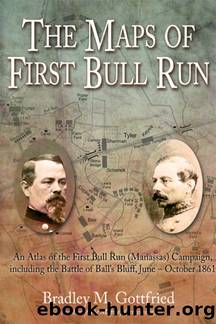Maps of First Bull Run An Atlas of the First Bull Run (Manassas) Campaign by Bradley Gottfried

Author:Bradley Gottfried
Language: eng
Format: epub
Tags: Bisac Code 1: HIS036050
ISBN: eBook ISBN: 978-1-61121-041-5
Publisher: Savas Beatie
Published: 2009-11-05T16:00:00+00:00
Map 35: Fighting North of Blackburn’s Ford (7:30 a.m.–4:00 p.m.)
McDowell needed to freeze in place the four Confederate brigades guarding the Bull Run fords so they could not reinforce their embattled comrades on Henry Hill. The task of feinting to hold the enemy was given to a pair of brigades led by Col. Israel Richardson (Tyler’s division) and Col. Thomas Davies (Miles’ division).1
Richardson had pushed his four regiments near the Butler house when Tyler’s guns opened fire early on July 21. Richardson likely savored the opportunity to take another shot at the enemy, for he had unsuccessfully fought them here on July 18. He ordered the 3rd Michigan into line east of the road leading to the ford, with seven companies of the 1st Massachusetts aligned on the right side (the three remaining Massachusetts companies were on skirmish and guard duty). His remaining two regiments, the 2nd Michigan and 12th New York, were posted north of the Butler house. Two four-gun batteries, Co. M, 2nd U.S. Artillery under Capt. Henry J. Hunt and Co. G, 2nd U.S. Artillery under Lt. Oliver Greene, galloped into position, unlimbered, and opened fire on the enemy batteries on the far side of Bull Run. Col. Davies’ brigade—the 16th, 18th, 31st, and 32nd New York regiments—deployed east of the road on Richardson’s left flank (No. 1 on map).2
The Confederates on the far side of Bull Run watched with growing concern as the enemy gathered in strength. The four Southern brigades protecting the crossings were arrayed as follows: Milledge Bonham at Mitchell’s Ford; James Longstreet at Blackburn’s Ford; David R. Jones at McLean’s Ford; and Richard S. Ewell at Union Mills. Bonham sent at least two scouting teams north toward the Butler house to ascertain enemy strength. During the mid-morning hours Longstreet, concerned about the growing losses enemy guns were inflicting on his men, sent most of his brigade across the stream to capture them (No. 2 on map). When he realized the Federals were in strength, Longstreet returned his soldiers to their positions on the south shore.3
Division leader Miles arrived on the scene about 11:00 a.m. Unhappy with Davies’ deployment, he ordered the 16th and 31st New York forward to a farm lane facing Little Rocky Run, pulled back the 18th New York into a supporting position, and left the 32nd New York along the Manassas-Centreville Road. He also rearranged the artillery. Richardson ordered his men to dig in to strengthen their position.4
Except for some fitful artillery fire, several hours passed without serious action. This convinced Gens. Johnston and Beauregard (as did the fact that the Federals were throwing up defensive works) that the threat here was a feint. By this time, the Confederates were fighting to hold the high ground on Henry Hill. Sometime between 1:00 and 2:00 p.m., two of Bonham’s regiments, the 2nd and 8th South Carolina, together with Kemper’s battery, were pulled away from Mitchell’s Ford to reinforce Henry Hill.5
Col. David R. Jones’s Brigade guarding McLean’s Ford was ordered at 11:30 a.
Download
This site does not store any files on its server. We only index and link to content provided by other sites. Please contact the content providers to delete copyright contents if any and email us, we'll remove relevant links or contents immediately.
| Atlases & Gazetteers | Historical |
| Travel Maps | United States |
| World |
Goodbye Paradise(2963)
Atlas Obscura by Joshua Foer(2350)
Tokyo by Rob Goss(2018)
Lonely Planet New York City by Lonely Planet(1845)
DK Eyewitness Top 10 Travel Guides Orlando by DK(1814)
Borders by unknow(1785)
Top 10 Dubai and Abu Dhabi by DK Travel(1716)
Tomb of the Panzerwaffe: The Defeat of the Sixth SS Panzer Army in Hungary 1945 by Aleksei Isaev & Maksim Kolomiets(1625)
Rick Steves London 2018 by Rick Steves & Gene Openshaw(1490)
Dirt by Bill Buford(1232)
Atlas of Improbable Places by Travis Elborough(1192)
the fault in our stars by john green(1187)
The Path Between the Seas by David McCullough(1184)
The Travels by Marco Polo(1152)
Tokyo on Foot by Florent Chavouet(1143)
The Lives of Conn Smythe by Kelly McParland(1099)
Need by Unknown(1095)
The Lord of the Rings: The Fellowship of the Ring, the Two Towers, the Return of the King by J. R. R. Tolkien(1081)
Top 10 Israel and Petra by DK Travel(1069)
